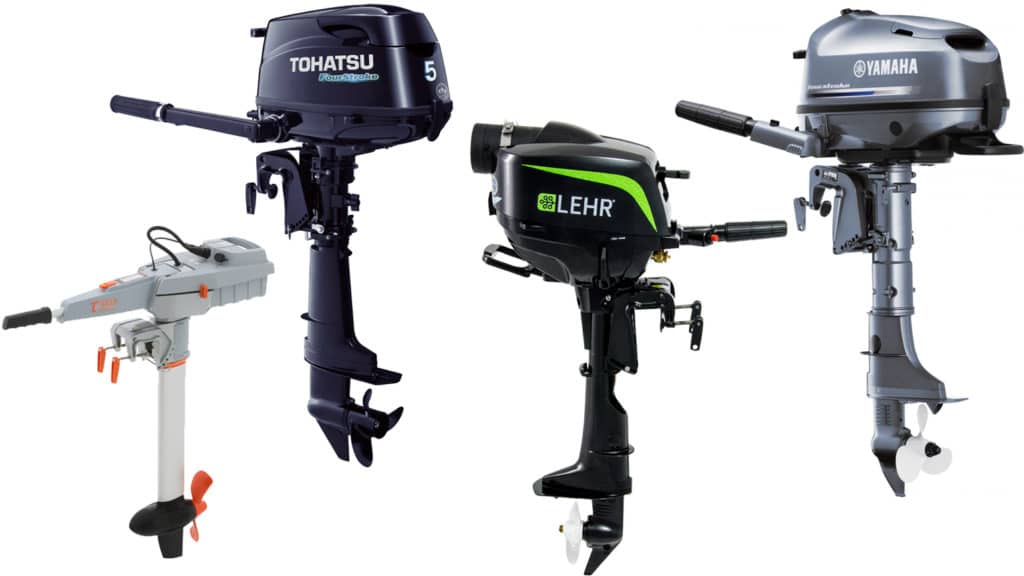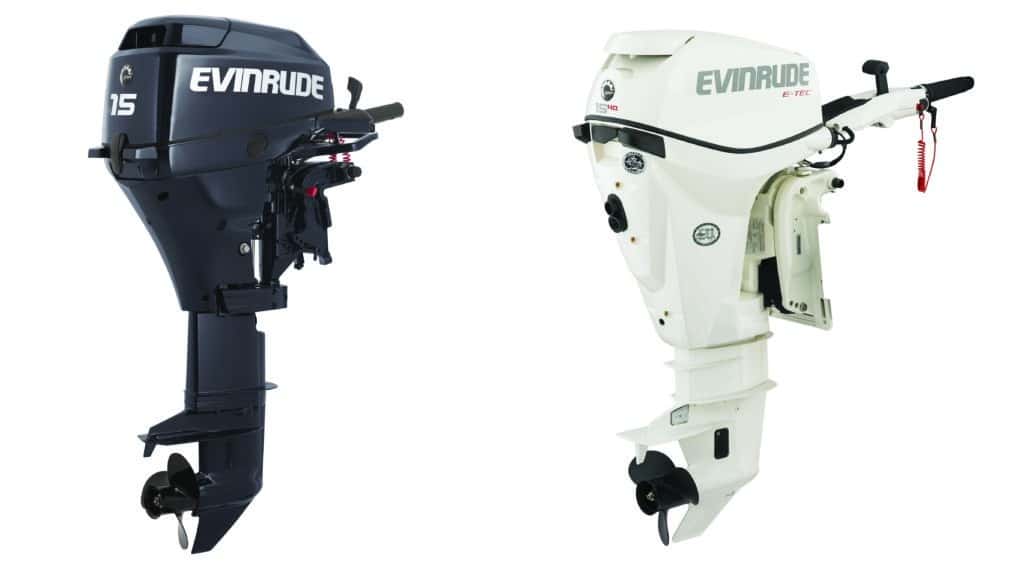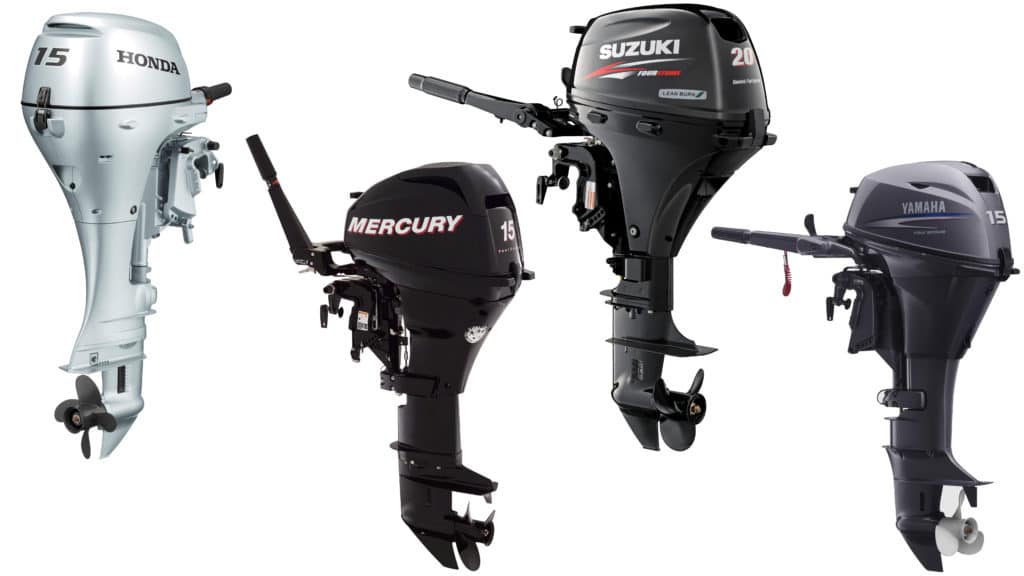
Every few years, I like to examine the latest and best options for powering up your dinghy or pocket cruiser. I followed the transition from relatively lightweight but smoky and smelly two-stroke engines to their much heavier but essentially smokeless four-stroke counterparts. But a lot has changed since my last look at what’s available in the marketplace. Now you have many choices: two-stroke or four-stroke, propane-fueled or electric, and carbureted or fuel-injected. So what’s best for your situation? Let’s take a closer look and let you decide.
What’s Available?
Your range of choices will depend on the size of your dinghy and whether you need to achieve planing speeds. A Torqeedo 1003, for example, can propel a boat weighing up to 3,000 pounds, but not planing. So one question you need to answer is whether planing is important to you; it’ll make a big difference in your choice of power.
Another important issue is ethanol fuel and the impact it has on outboard engines, especially low-horsepower engines. The fuel does go stale and will tend to absorb water, which ends up settling inside your engine’s carburetor. Additionally, the alcohol in ethanol acts as a solvent and will go a long way toward loosening up any sediment or other contaminants in your fuel system. As a result of water-contaminated fuel, I had to replace the entire carburetor on my three-year-old 3-horsepower four-stroke engine. The mechanic explained the problem quite well: These newer engines are so fuel-efficient that the carburetor jets are much smaller than equivalent-horsepower two-stroke engines of a decade ago. As a result, carburetor jets get plugged up quite easily, so ongoing problems with these engines are not uncommon, and clean fuel is imperative! Be advised that as of this writing, none of the major outboard engine manufacturers recommend any fuel over 10 percent ethanol, so E15 is categorically out. If you are lucky enough to live in a state that still sells no-ethanol fuel, I recommend taking that route, especially with carbureted engines.
Conversely, my fuel-injected outboard engine never misses a beat. A new fuel/water separator filter installed annually keeps everything running beautifully. Both Evinrude and Suzuki now offer 15-horsepower electronically fuel-injected engines. Those might address fuel problems, as my experience with fuel-injected outboard engines versus carbureted ones indicates that the fuel-injected units have fewer fuel-system problems. This is probably because the fuel-injected engine’s onboard CPU is programmed to compensate to some degree for minor fuel inequities; in other words, it has some inherent intelligence. Unfortunately, carburetors have an IQ of zero.
Last but not least, Lehr offers a propane fuel option in 2.5- to 25-horsepower configurations. With these units, you certainly don’t have to worry about clogged carburetors due to ethanol content, but they still have issues. Complaints in online forums question the quality of things like cover latches that break during normal use — a small but annoying matter.
The other issue is noise. In a comparison test conducted by BoatU.S., three things stood out on the Lehr 2.5-horsepower engine: It was noisier than the competition and it vibrated more, but on the plus side, it propelled the test boat faster than comparable motors in its class. By all reports, Lehr’s larger motors are not quite as noisy. Lehr also deserves some special kudos for its electric-start features; better yet, the company has designed the starter utilizing a 2-pound lithium-ion battery that is self-contained in the power head of the engine, eliminating the need for a separate battery that takes up space in an already cramped dinghy. These starters are available on Lehr’s 9.9-, 15- and 25-horsepower engines, meaning that all but the smallest dinghies could benefit from this feature. Another cool option for Lehr motors of up to 15 horsepower is the ability to use a small camp-stove-style propane bottle that screws right into a recess in the power head. It’s one less thing to take up space in the smaller dinghies that typically use these engines.

Weight Matters
A profound issue for all outboard engines is the great weight discrepancy between air- and water-polluting two-stroke models and the much more EPA-friendly four-stroke technology. The new four-strokes are typically much heavier. Depending on the specific tender you’re powering, as well as how you intend to store it on the mothership, weight can make a big difference in your choice. The difference between the 8-horsepower four-stroke engine I had on my 8-foot hard-bottomed inflatable and my three-year-old 3-horsepower four-stroke is quite noticeable; I can easily pull my dinghy up onto the dock at my yacht club now. Though now the dinghy won’t get up on a plane, I really don’t care, because I use it only in harbors, where the universal speed limit is 5 mph, to access my larger, moored boat.
The exceptions to the general rule of two-stroke engines being lighter than four-strokes in the same horsepower range are the new Evinrude E-TEC small engines. These motors are actually much heavier than their four-stroke counterparts, though still rated as appropriate for boats in the 100- to 300-pound weight range. Apparently, the fuel-injection system and all its trappings make a significant difference in weight, which is a difficult trade-off. I would prefer the fuel injection, but the weight difference is important, and for me creates somewhat of a dilemma.
What About Price?
Price may well be a deciding factor in your choice of a small outboard engine; I know it was for me. I really wanted to go electric on my dinghy, but the price of the Torqeedo was just a bit more than I wanted to spend. The Travel 1003, which would have worked fine on my tender, sells for just under $2,000. The closest thing I could find in a Lehr unit was the 2.5-horsepower model, which sells for $1,260, still a little rich for my taste. The Mercury 3-horsepower I purchased cost approximately $900. Of course, I ended up with several carburetor rebuilds and finally replaced it for about $300. That got me pretty close to the Lehr, but still out of reach of my electric-motor dream machine.
In the slightly larger motors, we see an almost $1,000 spread in price when we compare 20- to 25-horsepower motors. The Torqeedo product line is out of the mix here, as nothing it offers fits into this category. Lehr does offer the alternative to gasoline for fuel, but ranges in price from about $4,800 to $5,700, depending on specific equipment. The 25-horsepower Evinrude E-TEC fuel-injected engine is approximately $4,500. Honda offers only a 20-horsepower engine in this range, and it sells for about $4,100. All the other major vendors range from about $4,000 to $5,200, depending on whether you choose a long or short shaft, with or without electric start — and you’d have to be crazy or a real exercise fanatic to buy a 25-horsepower four-stroke outboard engine with manual start.
Are Warranties Comparable? Warranty coverage for your new outboard can be a tricky topic. Online, the basic coverage appears to range from two to five years (see sidebar below). Most vendors offer some sort of extended coverage for a fee, so look at the warranty offerings carefully, and be sure to pay close attention to the limitations spelled out. It could make a difference. Beyond the printed warranty, consider that some of the brands listed here, such as Lehr, Torqeedo, Mercury and Tohatsu, have expanded the traditional dealer network to include mass merchandisers that may not maintain comprehensive parts or full-service departments. No matter which brand of engine you decide is best for your dinghy, you will almost certainly be better off purchasing it at a full-service dealer for the brand you select. That way, you can be sure that there will be factory-trained parts and service personnel on staff to offer qualified help when you need it. You might spend a few hundred dollars more on the initial purchase price, but it’ll be worth it when your engine dies on July 4 and you need to find someone to get you going again.

Overseas Service
If you’re planning an extended cruise or maybe even international travel, you need to assess the size of the global service network for the motor you might purchase. You may be surprised by what you discover. Depending on your destination, you might find yourself waiting for that proverbial slow boat from China to get the next shipment of replacement parts for your new motor. Go online and do a search for specific engine brands and global dealer networks. Many brands, such as Tohatsu, Mercury and Lehr, offer a list right on their websites. The closest Lehr dealer to Grenada, as an example, is in Florida — not so helpful when your rather unusual propane-fired outboard engine mysteriously stops running after an extended Caribbean passage.
A Word About Nissan and Other Motors
Late in 2014, those of us in the business found out that Nissan motors were going to be phased out of the North American market. The Nissan Marine website (nissanmarine.com) now redirects you to a Tohatsu page that offers advice on parts and service. Keep in mind that the Nissan engines were always built by Tohatsu, just re-branded. While you can still find unused old stock at online outlets, I excluded Nissan from this article because availability of the brand will become quite limited over the next year or so.
Those who frequent large boat shows have probably run across some of the new-to-the-American-market Asian-built outboard motors at unbelievably low prices. Names like Hangkai and Parsun come to mind. Understand that everything I’ve said here regarding dealer network, service and parts availability still applies to these engines, and consider how much that lower-than-believable price means to you. Many years ago, a boat partner and I caved and bought a Cruise N Carry air-cooled outboard motor for our dinghy. The only thing the engine had going for it was that it was extremely inexpensive, really lightweight, and so simple I could take it apart and reassemble it with a pair of pliers and a No. 2 Phillips screwdriver, which I had to do essentially every year to keep ahead of the rust that would form on the recycled metal it must have been made out of. Fortunately, my partner left the motor on a dock one day, and someone stole it before he could get back to retrieve it. I consider that a lucky day, in retrospect.
Ed Sherman is vice president and education director at the American Boat & Yacht Council. He is also the author of Outboard Engines: Maintenance, Troubleshooting and Repair and answers questions at his blog, edsboattips.com.








